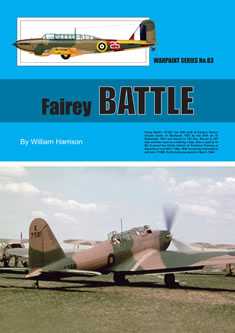
- aviationmegastore.com
- aviationoutletstore.com
- Ship to United States
Quick Search – Outlet Store
Aviation Outlet Store
categoriesFairey Battle
Product code WS-83
Fairey
€ 15.55
Series Warpaint Series No 83
Publisher/Brand Hall Park
Author William Harrison
Format a4
No. Pages 60
Version Soft cover
Language English
Category Aviationbooks
Subcategory WW2 UK » WW2 UK Aircraft
Availability only 1 remaining
This product was added to our database on Friday 5 August 2011.
Your reliable Aviation Book Source since 1989
Also in this series:
| product | Publisher/Brand | Series/scale | Price € | ||
 | Avro Lincoln | Hall Park | Warpaint Series No 34 | € 15.55 | |
 | Avro Manchester | Hall Park | Warpaint Series No 103 | € 14.63 | |
 | Avro Shackleton | Hall Park | Warpaint Series No 6 | € 12.80 | |
 | Boeing B17 Flying Fortress | Hall Park | Warpaint Series No 90 | € 18.30 | |
 | Fiat G91 | Hall Park | Warpaint Series No 49 | € 15.55 | |
 | Gloster Gladiator | Hall Park | Warpaint Series No 37 | € 17.39 | |
 | Lockheed Hudson MKI to MKVI | Hall Park | Warpaint Series No 59 | € 14.63 | |
 | Savoia Marchetti SM79 Sparviero | Hall Park | Warpaint Series No 61 | € 13.72 | |
 | Vickers Valiant | Hall Park | Warpaint Series No 63 | € 14.63 | |
 | Vickers Wellington | Hall Park | Warpaint Series No 10 | € 13.72 |
Product description
The Fairey Battle was not a failure!
British Prime Minister, Winston Churchill, said in the House of Commons on 20 August, 1940 - ....'on no part of the RAF does the weight of war fall more heavily than on the daylight bomber'.... . A reflection of what happened in the Low Countries during May/June 1940. The Battle was not mis-used during this debacle. The Air Staff, before the war, had planned against such an attack by Germany through the Low Countries, the Blitzkrieg was just outside their experience and the light bombers were thrust in at low level against a rapidly moving and heavily armed enemy.
It is also unfair for aviation journalists to compare the performance of a Battle against the new emerging single-engined fighters. It was a large but graceful design, and by contemporary standards was advanced for its day. Originally conceived within the limits of the Geneva Disarmament Conference the Battle would, by the time the second world war opened, have over 1000 aircraft in RAF service providing vital aircrew experience of a modern monoplane with a retractable undercarriage, variable-pitch propellers and hydraulic systems.
After withdrawal from front line squadrons the Battle airframe was adapted to provide experimental test bed work and give trainee aircrews extensive flying training in the UK, Australia, Canada, South Africa and Southern Rhodesia. More than half of all Battles built were later used in the training role - many continuing in use until 1945 or after!
Shopping cart
Your shopping cart is empty.
Login
Already a customer on our main website AviationMegastore.com? Your login is also valid in the outlet store.
- aviationshopsupplies.com
- aviationmegatrade.com
© 1989–2025 Luchtvaart Hobby Shop B.V.